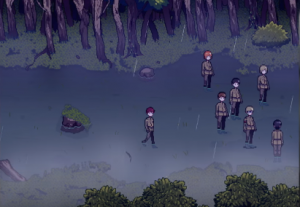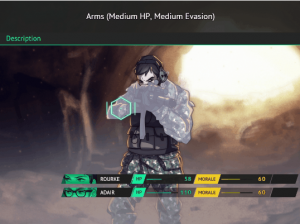One of the best things about Game-Wisdom is being able to talk to developers around the world about their games, and sometimes they find me. I was contacted by Camila Gormaz who is trying to get her game Long Gone Days funded via IndieGogo. The concept mixes JRPG design with a future setting around war and sounds very interesting. While the campaign is going on, she was kind enough to talk to me about the game and what she’s hoping to make if they hit their goal.
- To start with, could you tell us a little about yourself and background in the Game Industry?
I’m Camila Gormaz, an indiedev from Santiago, Chile. I have always been a fan of RPGs, and I have been making games since I was a teenager (from short Flash games, to commercial projects). On commercial projects, I usually handle the visual aspects of the game, from character design and illustrations, to the UI and logos. The last two commercial projects I worked on were visual novels; one of them is the first episode of Invisible Apartment.
- Where did the concept of Long Gone Days come from?
Since I liked RPGs so much, I started writing my own story when I was 12 years old. I wanted the story to take place in our current time, and to be as real as possible, without magic or superpowers. The most possible modern-day scenario for an RPG seemed to be the battlefield, so I began to shape my story around that. As I was studying about the lives of soldiers, I became attached to the strong feelings soldiers get to experience and how the circumstances shape them as a person.
- Given you background as an illustrator, how did you decide on what kind of art style to use for Long Gone Days?
While it’s true that Long Gone Days doesn’t really need to be drawn in an anime-style, it is the style I feel more comfortable with. For the sprites, I wanted to make the characters as tall as possible, and the current proportions were the most time-efficient size I tried. Any taller sprites would slow-down the production significantly.
- And continuing from that point. The art on the campaign shows two completely different art styles for the combat and exploration sections. Was this a conscious decision from the start or did this happen during development?
This was a hard decision. Since the demo is a prototype of the game, I had only a couple of months to put everything together. Most JRPGs use a side-view battle system, but these require a lot of animated sprites for every type of attack, and the demo would have taken a lot more time to be completed.
I decided to use a front-view battle system, like the one used on my favorite JRPG (Shin Megami Tensei titles). The battle system is still subject to change, but we are keeping the front-view.
- In terms of design and for people reading this post, how are you approaching the RPG/combat side of the game?
Every party member has a set of skills based on their expertise, and they all become necessary for the different missions the player will experience. Some party members will introduce crafting and weapon-upgrading skills; others will allow you to communicate with NPCs that do not speak your language.
The main battle system is a turn-based one, and it’s inspired by sniper tactics, where every body part of an enemy has a different chance of missing, and they serve different purposes (slowing the enemy down, disarming and eliminating). Besides that, it’s important to keep your team members motivated by understanding their fears, and encouraging them to keep fighting through dialogue.
- On the campaign, you mentioned that there will be no random encounters. This kind of design decision is interesting to talk about. Have you thought about how the balance of the game will be to prevent players from either being underpowered or mess up in terms of character growth?
The characters do not level up, since grinding would mean to go on a killing spree, while you are supposed to prevent a war. Instead of that, the player can craft and upgrade their weapons, they can learn new skills and get new party members, based on interactions, the quests they fulfill, the items they collect, and the progression of the story. As you get more party members, the formation you choose for every battle will be important.
[youtube]https://www.youtube.com/watch?v=ZhbHY4va6BE[/youtube]
- Given the unique story that you are building Long Gone Days around, do you see the game having replayability or multiple endings?
At the moment there are two endings planned that are equally extensive and they have two completely different outcomes. The ending you get is based on the decisions you have taken during the game. We also want to add a New Game+ feature and a third ending, but it will depend on our funding.
- To start to wrap things up, I have a few campaign-related questions. First, if you are able to make your goal, do you have a rough idea of how long development will take?
Since the beginning of the development, I have been working with schedules and they have worked fine. The 45-minutes long demo took 4 months to make, and I was handling everything by myself (from the writing, the art, the development, the marketing, etc), which means at least one month was spent designing and re-designing the battle system, the UI and other visual aspects, and another big percentage of that time was used on building an audience prior to the release of the demo.
For the full release, I am no longer working alone, and most of the designs are already decided, so including QA and testing, we expect to take less than a year and a half. To avoid delaying the release, if some of our stretch goals are met, they will be released after the main release.
- We’ve talked to a lot of developers who have gone the kickstarter route for their games, and not too many who went to Indiegogo. What made you decide to use it as your crowdfunding platform as opposed to kickstarter?
We know Kickstarter is the most popular option and we would have taken that route if it wasn’t because Kickstarter only allows residents from some countries in North America, Europe and Oceania to host projects. We truly hope Kickstarter changes its policy in the future, because there are a lot of amazing projects from the rest of the world. We are eternally thankful to Indiegogo for allowing pretty much every country in the world to be part of it, though.
- Lastly, do you have anything you would like to say to any fans reading this interview?
Do not give up and start building an audience early on during the development. It’s important to get feedback before launching, and not just from your friends, especially if it’s going to be a commercial game. By having an audience, you’ll push yourself to continue working hard.
Good luck with your campaign
I always find it interesting when developers attempt to change or grow JRPG design and I’m intrigued by the combat system Camila is talking about. We’re starting to see more games talk about the consequences of war such as This War of Mine, and I hope that Long Gone Days will be another one.
You can also download a free demo of the game to try it out.
If you’re a developer with an interesting game, I’m always looking for new contacts to either talk to them like this or on our cast, or spotlight on the site and Youtube channel. Just send me an email at josh@game-wisdom.com and we can talk.
If you would like to support Game-Wisdom, we are still running the patreon campaign to get the monthly funding we need to keep going. Your donations can also help us add more content for everyone to enjoy.



